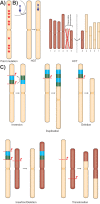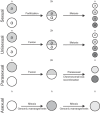Sex or no sex: evolutionary adaptation occurs regardless
- PMID: 24531982
- PMCID: PMC4158867
- DOI: 10.1002/bies.201300155
Sex or no sex: evolutionary adaptation occurs regardless
Abstract
All species continuously evolve to adapt to changing environments. The genetic variation that fosters such adaptation is caused by a plethora of mechanisms, including meiotic recombination that generates novel allelic combinations in the progeny of two parental lineages. However, a considerable number of eukaryotic species, including many fungi, do not have an apparent sexual cycle and are consequently thought to be limited in their evolutionary potential. As such organisms are expected to have reduced capability to eliminate deleterious mutations, they are often considered as evolutionary dead ends. However, inspired by recent reports we argue that such organisms can be as persistent as organisms with conventional sexual cycles through the use of other mechanisms, such as genomic rearrangements, to foster adaptation.
Keywords: adaptation; asexual; genome evolution; meiosis; mitosis; recombination.
© 2014 The Authors. Bioessays published by WILEY Periodicals, Inc.
Figures




Comment in
-
Learn from the fungi: adaptive evolution without sex in fungal pathogens (comment on DOI 10.1002/bies.201300155).Bioessays. 2014 Apr;36(4):334. doi: 10.1002/bies.201400030. Bioessays. 2014. PMID: 24599722 No abstract available.
-
Evolution in the absence of sex: Ideas revisited in the post-genomics age (retrospective on DOI 10.1002/bies.201300155).Bioessays. 2016 Dec;38(12):1191. doi: 10.1002/bies.201600195. Epub 2016 Sep 19. Bioessays. 2016. PMID: 27642029 No abstract available.
References
-
- Stukenbrock EH. Evolution, selection and isolation: a genomic view of speciation in fungal plant pathogens. New Phytol. 2013;199:895–907. - PubMed
-
- Chisholm ST, Coaker G, Day B, Staskawicz BJ. Host-microbe interactions: shaping the evolution of the plant immune response. Cell. 2006;124:803–14. - PubMed
Publication types
MeSH terms
LinkOut - more resources
Full Text Sources
Other Literature Sources
Research Materials

